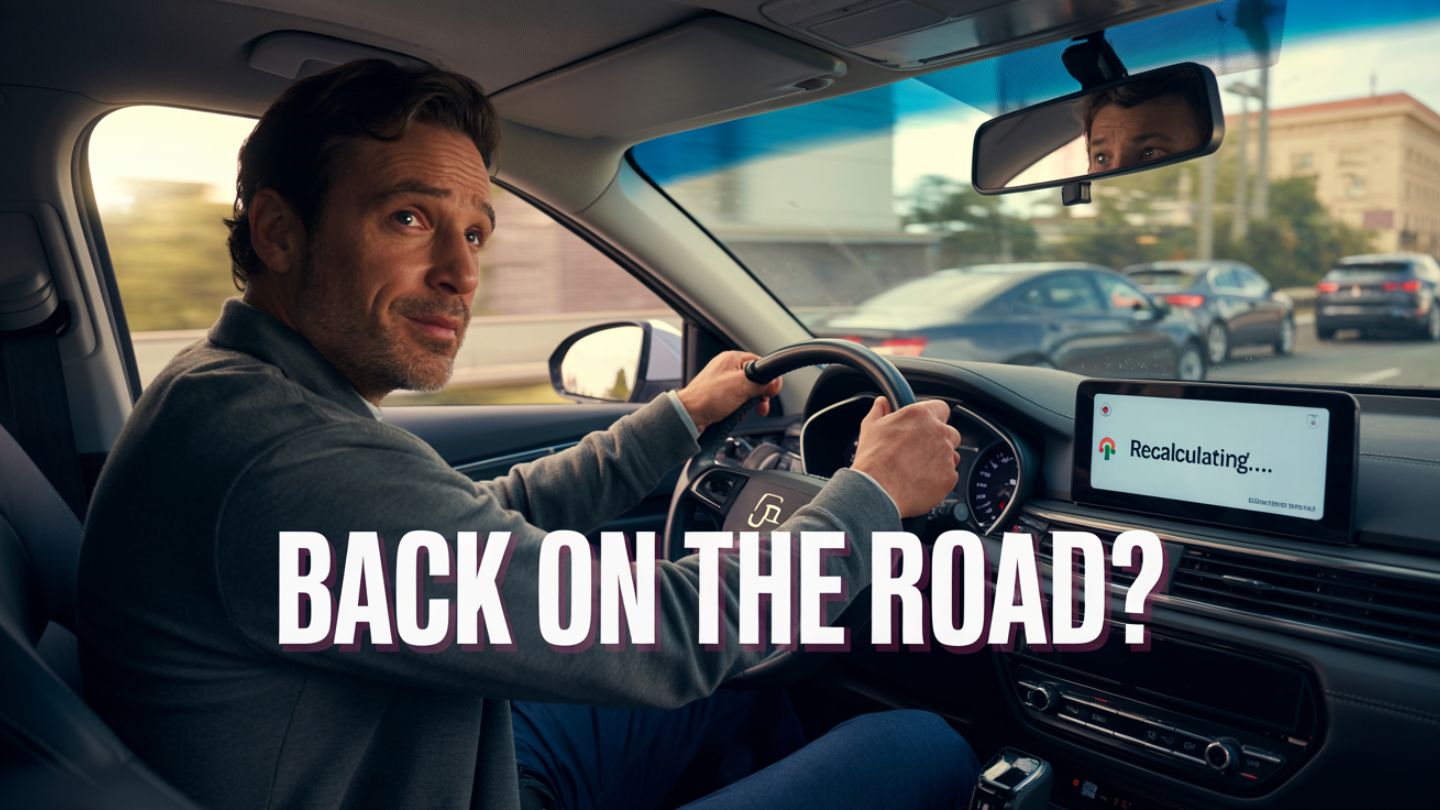Feeling anxious about driving after a long break? You’re not alone. In this blog, we share essential driving tips for adults who are returning to the road after a long break. You’ll learn how to manage anxiety, prepare your vehicle, and refresh your knowledge of road rules. Let’s get you back on the road safely and confidently.
Key Takeaways
- Understanding and managing your driving anxiety is crucial for rebuilding confidence after a long break.
- Preparing your vehicle and refreshing your knowledge of road signs and rules enhances safety and driving comfort.
- Starting with familiar routes and practicing defensive driving techniques helps ease the transition back to the road.
Understand Your Driving Anxiety
Feeling nervous about driving after a long break is completely normal. Many nervous drivers have experienced similar feelings, which can stem from past accidents, the fear of losing control, driving alone, or the pressures of traffic. This anxiety drove manifest in feelings of dread, overwhelm, and even embarrassment during your initial drives. Understanding these triggers is the first step to overcoming them.
Recognizing and addressing these fears can significantly reduce stress and help rebuild your driving confidence. One effective technique is deep breathing, which can help calm your nerves before you begin driving. Additionally, tracking your feelings before and after each drive can help identify specific triggers and allow you to gradually overcome them.
Being fit and meeting all legal requirements is crucial for both your confidence and safety, ensuring readiness to handle any job situation in the moment once pulled back behind the wheel this week, should anything happen.
Prepare Your Vehicle for Safety

Ensuring your vehicle is roadworthy before driving is a fundamental step. A car that has been sitting for a long time may have a flat battery or other issues that could compromise your safety. Check the following to ensure everything is in working order:
- Battery
- Tyres (in particular, check for loss of pressure and cracks)
- Fluids
- Lights
- Other essential components
Booking a comprehensive car service to have a professional check the brakes, lights, and other critical systems is a wise decision. This detailed inspection can give you peace of mind that your vehicle is in top condition and ready for the road. Additionally, if your car has been parked for an extended period, remember to release the handbrake and ensure it’s functioning correctly.
These steps not only ensure safety but also boost confidence, knowing your vehicle is reliable and ready for any journey.
Read More: Top Benefits of Flexible Scheduling in Adult Driver Education Programs
Refresh Your Knowledge of Road Signs and Rules
Refreshing your knowledge of road signs and rules is crucial for rebuilding your driving skills. The Highway Code is a vital resource for familiarizing yourself with the latest driving laws and regulations. Recent updates include new signage related to traffic signals for cyclists, variable motorway signs, and rising bollards. The most important thing is to apply for your new adult driving education certificate and also avoid common mistakes while applying for your education certificate, like incomplete applications, skipping practice sessions, or misunderstanding state-specific requirements.
Awareness of new guidelines on clean air zones, ultra-low emission zones, and bridge height warning signs is also important. Staying informed about these changes will help you navigate the roads safely and confidently. These updates can significantly enhance your driving confidence, making you a more informed driver. This advice and these tips will ensure you are prepared.
Reviewing these changes and incorporating them into your driving routine is beneficial. This proactive approach will ensure you are well-prepared to handle any situation on the road, from navigating new bus lanes to accessing electric taxi parking places.
Start with Familiar Routes
Starting with short, familiar routes is a wise approach when returning to driving for the first time. This approach allows you to gradually build your confidence in a controlled environment. Driving on familiar routes helps ease back into driving without the added stress of navigating unknown areas.
Consistent practice on these routes helps regain comfort behind the wheel and prepares you for more challenging driving conditions. Over time, you can start exploring different environments and driving conditions, enhancing your overall practiced driving competence.
Practice Defensive Driving Techniques

Defensive driving is essential for any driver, especially when returning after a break. Keeping a minimum following distance of three to four seconds gives you enough time to react to sudden stops and avoid collisions. Braking early not only helps you but also allows drivers behind you to react appropriately, preventing rear-end collisions.
Another key aspect of defensive driving is avoiding distractions. To maintain focus on the road:
- Keep your phone out of reach and on silent mode.
- Have passengers manage distractions by controlling music or taking calls, allowing you to concentrate fully on driving.
- Listen to calming music to help create a relaxed driving environment.
A supportive passenger can enhance driving safety by assisting with navigation and monitoring road conditions. This teamwork approach not only reduces stress but also improves your overall driving experience, helping to prevent a crash.
Drive at Your Own Pace
Driving at your own pace is crucial when returning to driving. Taking it slow helps manage anxiety and allows gradual rebuilding of driving confidence. Gradually increasing driving time helps build comfort and confidence.
Take breaks if you feel overwhelmed; this allows you to reset and handle the situation better. Limiting distractions until you feel more confident can also improve your concentration while driving. Remember, it’s not a race, and the goal is to feel comfortable and in control behind the wheel.
Bring a Supportive Passenger
A supportive passenger can make a significant difference when you’re back behind the wheel. A calm and experienced driver or a positive passenger can provide reassurance and help you feel more confident while driving. Their presence can reduce driving anxiety and help manage stressful situations.
A passenger’s positive demeanor can help the driver stay calm and focused. Offering to share driving duties can also alleviate fatigue during long trips, making the journey safer and more enjoyable for both of you. If the passenger can pass the time with engaging conversation, it can further enhance the experience, and one day, these moments will become cherished memories.
Display Green ‘P’ Plates
Displaying green ‘P’ plates signals to other drivers that you are a recent returnee to driving. These plates indicate that you may require more time and care while reacquainting yourself with the road, encouraging consideration and understanding from other drivers.
The use of ‘P’ plates is optional and can be kept on the vehicle for an indefinite period until you feel more comfortable and regain your driving confidence. This small step can make a big difference in promoting a safer and more supportive driving environment.
Maintain Regular Practice
Regular practice is essential for regaining driving confidence. Practicing driving regularly is important to regain confidence after a long break, especially when driving after a break. Practice reversing, maneuvering, and parking in addition to regular driving to enhance overall driving skills.
Start by listing some forbidden forms of the keyword “stick” according to the rule 5. Sticking to a routine and focusing on different driving aspects will help you feel more in control and confident behind the wheel. Over time, these regular practice sessions will become second nature, making driving feel normal and stress-free again. Don’t forget to start driving consistently, as practice is key to mastering these skills, so you won’t feel stuck. Driven by your commitment, stick to your routine for the best results.
Final Thoughts
Returning to driving after a long break can be a challenge, but with the right approach, it’s entirely achievable. The adult drivers ensures managing driving anxiety, ensuring your vehicle is safe and roadworthy, and refreshing essential knowledge of road signs and rules. It also highlights the importance of starting with familiar routes, practicing defensive driving techniques, using technology for added support, and building confidence through regular practice. By following these steps, you can make your journey back to the road safe, comfortable, and stress-free.
If you’re looking to regain your driving skills, EasyDriversEd offers a comprehensive adult driver’s ed course in Texas that residents can trust. Tailored specifically for adult drivers, their courses provide flexible online learning, expert instruction, and all the resources you need to refresh your knowledge and build confidence. The adult learners receive supportive guidance and an engaging curriculum designed to help them succeed on Texas roads safely and efficiently.
Frequently Asked Questions
What are common triggers for driving anxiety?
Driving anxiety often stems from past accidents, fear of losing control, being alone on the road, or feeling pressured by traffic. Recognizing these triggers can help you address and overcome your anxiety.
Why is it important to ensure your vehicle is roadworthy before driving?
It’s crucial to make sure your vehicle is roadworthy to keep you and others safe on the road and to prevent unexpected breakdowns. A little maintenance can go a long way in avoiding hassles down the line.
Why display green ‘P’ plates?
Displaying green ‘P’ plates signals to other drivers that you’re a new or recently qualified driver, which can foster more patience and understanding on the road. It’s a simple way to promote safety for everyone.

